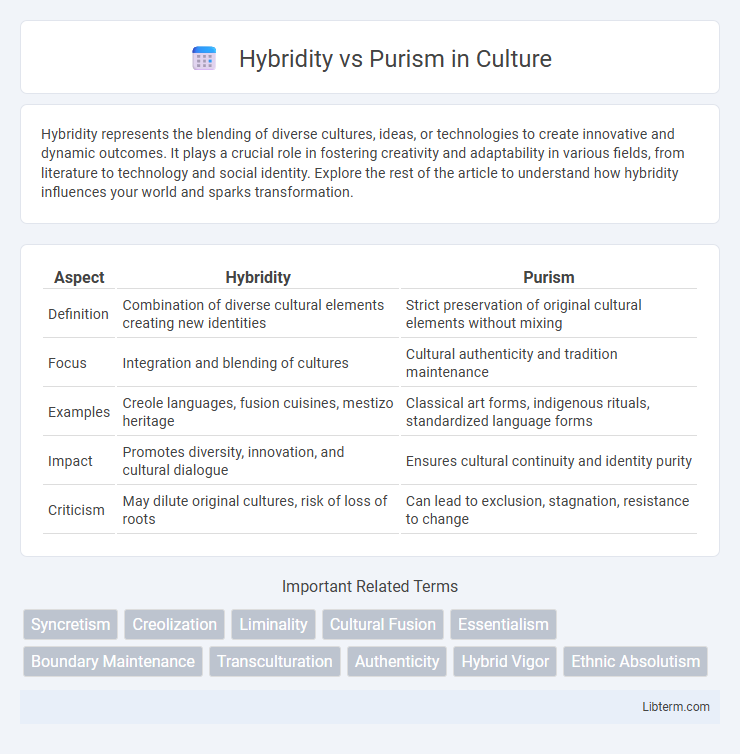Hybridity represents the blending of diverse cultures, ideas, or technologies to create innovative and dynamic outcomes. It plays a crucial role in fostering creativity and adaptability in various fields, from literature to technology and social identity. Explore the rest of the article to understand how hybridity influences your world and sparks transformation.
Table of Comparison
| Aspect | Hybridity | Purism |
|---|---|---|
| Definition | Combination of diverse cultural elements creating new identities | Strict preservation of original cultural elements without mixing |
| Focus | Integration and blending of cultures | Cultural authenticity and tradition maintenance |
| Examples | Creole languages, fusion cuisines, mestizo heritage | Classical art forms, indigenous rituals, standardized language forms |
| Impact | Promotes diversity, innovation, and cultural dialogue | Ensures cultural continuity and identity purity |
| Criticism | May dilute original cultures, risk of loss of roots | Can lead to exclusion, stagnation, resistance to change |
Defining Hybridity and Purism
Hybridity refers to the blending of diverse cultural elements, languages, or identities resulting in a new, mixed form that transcends traditional boundaries. Purism emphasizes maintaining a single, unadulterated cultural, linguistic, or ideological system, resisting external influences to preserve originality. These concepts play critical roles in discussions of identity, language evolution, and cultural preservation.
Historical Roots of Hybridity
Historical roots of hybridity trace back to colonial encounters where cultural exchanges produced blended identities and practices, challenging notions of pure, fixed cultures. Scholars like Homi Bhabha emphasize hybridity as a space of negotiation and resistance that disrupts colonial power dynamics. This concept contrasts with purism, which seeks to maintain cultural or linguistic purity by opposing cross-cultural influences and changes.
Origins and Appeal of Purism
Purism originated in linguistic and cultural movements aiming to preserve the perceived purity and authenticity of a language or tradition by resisting foreign influences and hybrid forms. This approach appeals to communities seeking to maintain clarity, identity, and continuity with historical roots, often emphasizing standardized norms and classical references. Purism's appeal lies in fostering a sense of pride and cultural unity, counteracting the complexity and ambiguity associated with hybridity.
Cultural Impacts of Hybrid Approaches
Hybrid approaches in culture foster dynamic exchanges that challenge rigid boundaries, promoting diversity and innovation by blending traditions from multiple origins. This synthesis enhances intercultural understanding and creates new, inclusive identities that reflect contemporary societal complexities. Embracing hybridity counters purist perspectives that may limit cultural evolution and marginalize minority narratives.
Purism in Art, Language, and Identity
Purism in art emphasizes the preservation of original forms and styles, rejecting external influences to maintain cultural and aesthetic purity. In language, purism advocates for the conscious avoidance of foreign loanwords, promoting native vocabulary and grammatical structures to safeguard linguistic heritage. Identity purism fosters a strict adherence to traditional customs, beliefs, and values, resisting hybridity to preserve a unified and authentic cultural self-definition.
The Role of Hybridity in Innovation
Hybridity plays a crucial role in innovation by combining diverse cultural, technological, or disciplinary elements to create novel solutions and breakthrough ideas. This fusion fosters creative problem-solving and enables the emergence of unique products, services, or artistic expressions that pure or isolated systems may not achieve. Embracing hybridity accelerates adaptability and drives competitive advantage in rapidly evolving markets.
Challenges and Criticisms of Purism
Purism faces challenges such as linguistic rigidity that stifles natural language evolution, making it difficult to adapt to cultural and technological changes. Critics argue that strict adherence to language purity can alienate speakers and hinder effective communication by rejecting widely accepted loanwords and expressions. This inflexibility often leads to resistance from language communities who favor a more hybrid, dynamic approach to language development.
Benefits and Drawbacks of Hybridity
Hybridity fosters innovation by blending diverse cultural elements, enhancing creativity and adaptability in globalized contexts. It encourages cross-cultural understanding and expands expressive possibilities but may dilute traditional identities and cause conflicts over authenticity. Maintaining a balance between hybridity and purism is crucial to preserve cultural integrity while embracing dynamic change.
Case Studies: Hybridity vs Purism in Practice
Case studies on hybridity vs purism reveal distinct approaches in cultural and linguistic contexts, showing hybridity fosters innovation by blending diverse elements, as seen in creole languages and fusion cuisines. Purism emphasizes preservation and authenticity, exemplified by language academies like the Academie Francaise promoting linguistic purity to maintain cultural heritage. Practical outcomes vary, with hybridity encouraging adaptability and creativity while purism ensures tradition and identity continuity.
Looking Forward: Balancing Hybridity and Purism
Balancing hybridity and purism involves embracing innovation while preserving cultural integrity, enabling adaptive growth in language, art, and identity. Future strategies should emphasize selective integration of external elements to maintain core traditions without resisting necessary evolution. Sustainable progress relies on dynamic equilibrium, where hybridity enriches purism and purism provides stability to hybridity.
Hybridity Infographic

 libterm.com
libterm.com